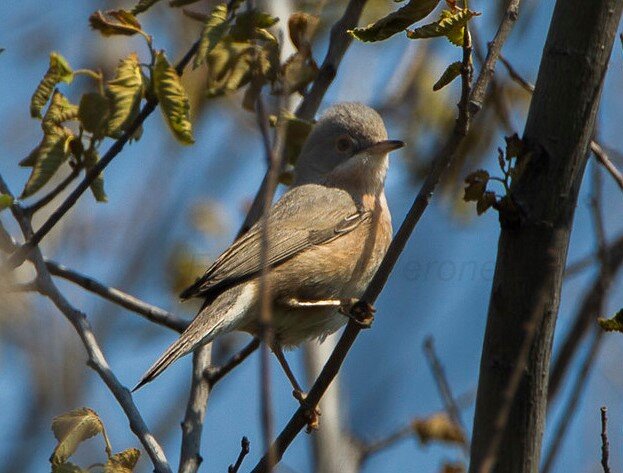Moltoni's Warbler
Curruca subalpina (Temminck, 1820) (1, 0)
Photo © By Francesco Veronesi - https://www.flickr.com/photos/francesco_veronesi/19297643255/, CC BY-SA 2.0, https://commons.wikimedia.org/w/index.php?curid=51532642
STATUS
Balearic Islands, Corsica, Sardinia and north-central Italy. Monotypic.
OVERVIEW
In their 10th Report of Taxonomic Recommendations (Ibis 157: 193-200) the sub-committee of the BOURC (2015) decided that the Moltoni's Warbler should be split from Subalpine Warbler to give it full species status.
Plumage and genetic analysis was carried out by the BOURC (2013) of the first British record from St Kilda which was previously accepted as nominate cantillans, unambiguously showed that it was a Moltoni’s Warbler S. moltonii.
RECORD
1). 1894 Outer Hebrides St Kilda, male, 13th to 14th June when shot, now at Natural History Museum, Tring (BMNH 1901.1.4.1).
(R. Bowdler Sharpe, Bulletin of the British Ornithologists' Club 4: 9; J. Steele Elliot, Zoologist 1895: 282; Eds., Annals of Scottish Natural History 1895: 97; J. A. Harvie-Brown, Annals of Scottish Natural History 1902: 142; Clarke, 1912; Witherby, 1920-24; Thom, 1986; Forrester & Andrews et al., 2007; BOURC (2013), Ibis 156: 237).
History R. Bowdler Sharpe, Editor (1894) in the Bulletin of the British Ornithologists' Club, Vol. IV. p. 9, at the 21st Meeting of the Club held on 19th December 1894 at the Restaurant Frascati, London, says: 'Dr. R. Bowdler Sharpe exhibited a specimen of a bird new to the Fauna of Great Britain. This was an example of the Subalpine Warbler (Sylvia subalpina), which had been forwarded to him for exhibition by Mr. J. S. Elliott, of Dudley, who had shot it himself on the island of St. Kilda on the 13th of June, 1894, after a heavy gale from the south-west.'
J. Steele Elliot (1895) in The Zoologist, 3rd series, Vol. XIX. p. 282, says: 'A specimen of this little warbler was obtained. I first noticed it haunting the Minister's garden on June 13th, busily employing itself seeking for food along a row of young peas, and it frequently flew to a parsnip in seed that grew in one corner of the garden; the latter plant seemed to attract a greater number of insects, and it was my particular spot for securing various Diptera, &c.
This little bird allowed people to approach quite close to it, and I was able to take full particulars of its plumage within a few feet. It remained throughout Sunday till the following day, when I shot it in the presence of Mr. Fiddies and Mr. McKenzie, the factor. It was at once placed in spirit and forwarded direct to Mr. Cullingford, of Durham, for preservation. Its sex could not be ascertained with certainty.
It was exhibited to the members of the British Ornithologists' Club in December last by Mr. Bowdler Sharpe. Its presence on the island was probably caused by the great gale that blew across the island the previous day (June 12th) from the S.W. It is remarkable that the species should be first obtained in the British Islands in such a northern and out-of-the-way locality as St Kilda.'
In an Editorial (1895) in the Annals of Scottish Natural History, Vol. IV. p. 97, they say: 'At the meeting of the British Ornithologists' Club held in London on the 19th of December 1894, "Dr. Bowdler Sharpe exhibited a specimen of a bird new to the fauna of Great Britain. This was an example of the Subalpine Warbler (Sylvia subalpina), which had been forwarded to him for exhibition by Mr. J. S. Elliott, of Dudley, who had shot it himself on the island of St Kilda on the 13th of June 1894, after a heavy gale from the south-west"....'
Clarke (1912 (2): 214) under 'The Birds of St Kilda', says: 'Subalpine Warbler - One was observed on 13th June 1894, and was shot on the following day in the Manse garden by Steele Elliot (Zoologist 1895: 282). The sex of the specimen is said not to have been determinable.
A gale of wind had been blowing from the south-west on the day previous to its appearance.'
Forrester & Andrews et al. (2007 (2): 1227) add: 'Specimen now at Natural History Museum, Tring (BMNH 1901.1.4.1).'
